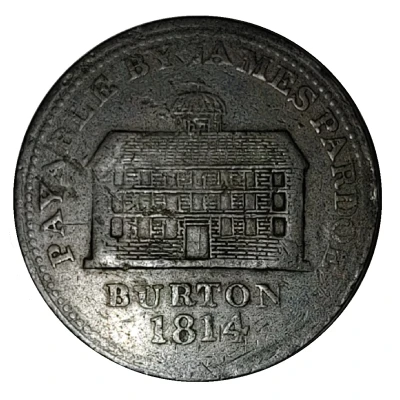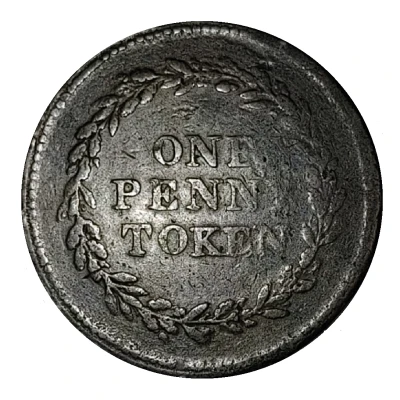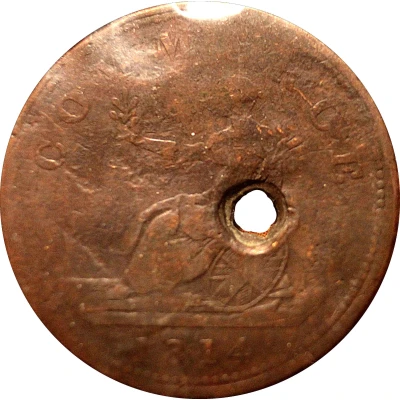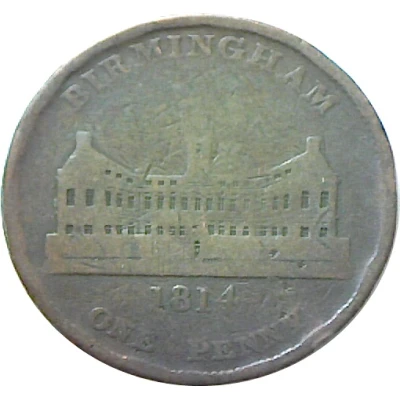
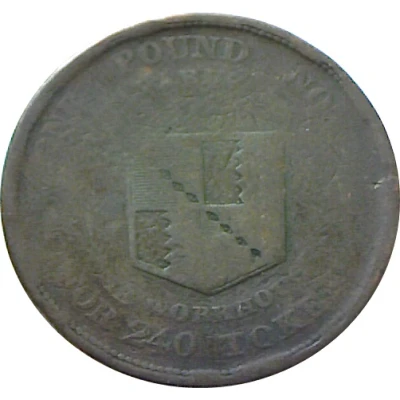

© ZacUK
1 Penny Worcestershire - Birmingham / Workhouse
1814 year| Copper | 28.54 g | 37 mm |
| Issuer | United Kingdom (United Kingdom, British Overseas Territories and Crown Dependencies) |
|---|---|
| Type | Token |
| Year | 1814 |
| Value | 1 Penny (1⁄240) |
| Currency | Currency tokens (1798-1816) |
| Composition | Copper |
| Weight | 28.54 g |
| Diameter | 37 mm |
| Thickness | 2.8 mm |
| Shape | Round |
| Technique | Milled |
| Orientation | Coin alignment ↑↓ |
| Demonetized | 1817 |
| Updated | 2024-10-09 |
| Numista | N#89655 |
|---|---|
| Rarity index | 82% |
Reverse
Shield in centre. Legend in two lines both above and below, beaded border
Script: Latin
Lettering:
ONE POUND NOTE FOR 240 TOKENS
PAYABLE AT THE WORKHOUSE
Edge
Central diagonal milling \ \ \ \
Comment
Birmingham Workhouse (Warwickshire) copper penny token dated 1814.The Birmingham Workhouse for the Overseers of the Poor was located in Lichfield Street, Birmingham and accommodated 600 paupers and children at its peak.
The Workhouse, Birmingham, Warwickshire. Up to 1834:
On 3rd April 1734, a meeting was held and orders given for the purchasing of a site and building of a workhouse for the parish of Birmingham (Dent, 1893). The workhouse was erected soon afterwards on land between Lichfield Street and Steelhouse Lane, where Coleridge Passage now stands. The building cost £1,173 and was intended to accommodate 600. Later extensions included an infirmary wing at the left erected in 1766 at a cost of £400, and a workshop wing at the right erected in 1779 at a cost of £1,100.
In 1783, Birmingham was incorporated under a local Act of Parliament, giving it greater powers over the management of poor relief. The Incorporation was managed by a body of 108 Guardians of the Poor and was enabled to set up a workhouse "with Apartments for the sick and diseased, and for the old, impotent and infirm, and for those able to work, for the carrying on divers Trades, Works, and Manufactures, as also for the Punishment of the idle, refractory, and profligate". In fact, the Incorporation appears to have continued using the existing parish workhouse building for a further 70 years. By 1848, it could accommodate 645 inmates and was generally full.
In 1789, Josiah Robins, a worsted maker in Digbeth, was given permission to set up a workshop in premises adjoining the workhouse, and to employ the inmates. Their earnings were paid each week to the workhouse governor. Some inmates, who were deemed capable, were appointed as instructors and supervisors and given separate accommodation at the workhouse.
From around 1812, during a national shortage of coins, Birmingham was one of several workhouses to issue workhouse tokens - specially minted coins given as poor relief. Local shopkeepers could then redeem the tokens at the workhouse. This example, from 1814, features a picture of the Incorporation workhouse, and the wording "ONE POUND NOTE PAYABLE AT THE WORKHOUSE FOR 240 TOKENS".
Interesting fact
One interesting fact about the Token 1 Penny (Worcestershire - Birmingham / Workhouse) 1814 from United Kingdom is that it was used as a form of currency in workhouses, which were established by the Poor Law Amendment Act of 1834 to provide relief for the poor and destitute. The coin was made of copper and weighed 28.54 grams.
